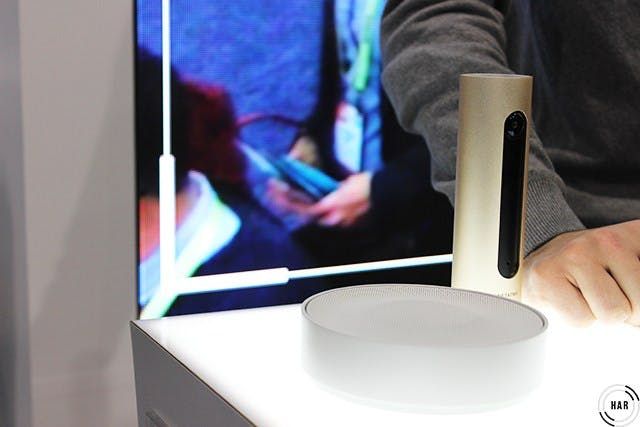
Do you know what makes smart homes smart? Processing power.
Smart cameras can only recognize your face after they’ve processed an image; voice-controlled devices can only understand you after they’ve processed a sound, and your smart home hub can only tell what’s going on in your house after its processed the input from your sensors.
As simple as it may sound, processing is critical, and the “process” takes memory, power, and software. And when it comes to the smart home, the question is, “Should devices process locally or in the cloud?”
Local vs. Cloud for the Smart Home
There are undeniably more manufacturers looking to cloud-based services to provide the processing power their devices need. Why?
First, it’s more convenient for manufacturers. They don’t need to program each device to analyze complex data. Instead, of programming each device to analyze complex data, they simply upload processing algorithms to the cloud. Their devices transfer data to the cloud, which does all the heavy-lifting.
Second, the cloud can handle more complex processing. Think of it like this: you can’t run Photoshop on your iPhone, but you can run it on a decent computer. Smart devices aren’t always powerful enough to do the job, so the Cloud acts as a computer – doing the work and letting your less powerful device take all the credit. Amazon Echo is an example of a device that uses cloud-based services to analyze data. Could Amazon have made Echo with local processing? They could have, but that might have taken away Echo’s ability to understand rich, natural language and more importantly, it might have made the device less affordable.
However, cloud-based processing doesn’t come without trade-offs, the biggest of which is the possibility of a privacy breach. Data travels from your device to the cloud—data you might not want someone else to see. This includes video from your home security camera, your arrival/departure times sent from your smart lock, and your home address set within your smart hub. While manufacturers assure us that data is encrypted and secure, there’s no assurance that a device is hack-proof.
Another downside of devices relying on the cloud is that they also rely on the internet: when the internet goes down, your smart home goes down. Leaving you unable to control your lights, locks, thermostat, and other smart home devices. The case for devices that process locally is that they are more secure and can work even when your internet is down.
Smart Home Devices That Work Locally
While smart devices that work with the cloud are a dime-a-dozen, devices that have some sort of local processing ability are still rather rare. Here’s our list of smart home devices that can perform locally. The newest trend is a hybrid solution: devices use the cloud but aren’t completely dependent upon it.
Smart Home Hubs
RECOMMENDED HUB: Hubitat
Hubitat, often compared to SmartThings, is an inexpensive hub that talks to a variety of smart home devices. It’s customizable to almost the same extent as SmartThings, making it an appealing choice for tinkerers and developers. The major difference, however, is that Hubitat is capable of running everything offline, including rule-based automation, manual smart home control, and even geofencing.
The Hubitat hub connects to your devices via IP or Wi-Fi, so some of your devices might require an internet connection to work with Hubitat. However, you can plug a Z-Wave/Zigbee stick into the hub to enable it to connect to Z-Wave and Zigbee devices for total local access…no internet required. The new Hubitat hub will include built-in Z-Wave and Zigbee radios, making the process even easier.
SmartThings Hub
Samsung’s SmartThings hub uses a combination of cloud and local processing.
For example, it uses a cloud-to-cloud connection to control Nest Thermostats, so when your internet’s down, you can’t control Nest. You also can’t control individual devices or anything using the SmartThings mobile app.
Without internet, SmartThings can only run some preconfigured automations locally. According to SmartThings Support,1 it can run some scenes, known as SmartApps.
Locally-run SmartApps are stored on your SmartThings hub your hub will still run them without internet. But there are exceptions— only Smart Home Monitor and Smart Lights SmartApps can be configured to work locally. You also can’t run a SmartApp locally if it affects both local and cloud devices. Plus, mode changes won’t trigger a locally-run SmartApp. For example, an App that turns on your lights when you set SmartThings to Home Mode won’t work. As an alternative, you could create an App to turn on your lights at 6 pm.
Read Our SmartThings Review Here
Oomi Camera and Smart Home Hub
Oomi is a smart home system centered around its camera-hub called Oomi Cube. With Oomi, cloud data processing is offered, but not required. Processing commands are local, so you are in control even without the cloud. But using the cloud does have benefits: it will improve analytics and machine learning, thus making your system smarter.
Mixtile
Mixtile works without the cloud. The hub boasts a ton of processing power:1.2GHz Cortex A7 processor, 1GB DDR3 RAM, and 8GB of storage. It has the power to store and activate home automation scenes, and even listens to basic voice commands, although its ability to understand is limited. Unlike Alexa, it can’t understand rich, natural language but it can perform standard functions such as turning on lights.
Take note that if Mixtile is not connected to the cloud, you won’t be able to control it using your phone. However, if you’re at home and if your phone is connected to your router, even if there’s no internet connection, you’ll still be able to control Mixtile.
Vera
If you’re concerned about controlling your smart home during a blackout, you may want to consider is Vera Smarter Home Control. With both battery and cellular functionality, Vera’s devices guarantee control over your smart home security system and other battery-powered smart-home—even during outages.
Vera offers three smart home controllers with varying features: VeraSecure, VeraPlus, and their more basic VeraEdge. All three devices work with Z-wave at a minimum, and range in price from $69.95 (VeraEdge) to $249.95. All three devices have an optional battery backup and 3G wireless connection, although the VeraSecure is the only one that comes with these features included with the base purchase.
Finally, a number of big-name integrations work with Vera, including Amazon, 2GIG, Go Control, Bosch, Honeywell and more. So long as you have smart home devices that also include Z-Wave, Vera’s controllers should give you full access to most of your smart home, even when the lights go out and Wi-Fi goes down.
nCube Base
Like Mixtile, nCube processes everything on-board. No logic goes to the cloud. If you create an automation scene, rule, or schedule, they are saved to nCube’s built-in storage device.
In addition, nCube will sell modules that will expand nCube’s features. One of the modules, the Security Layer, adds cellular and battery backup.
Home Security Cameras
RECOMMENDED CAMERA: Butterfleye or Ooma Smart Cam
Butterfleye is a cordless home security camera that can work without internet and without power. It offers person recognition and the intelligence lives on the device, not in the cloud. However, if an unknown face is detected, the camera will record footage and send it to the cloud for storage, unless your internet is out or you’re using the camera on the go.
Butterfleye ships with an onboard storage device. The original camera has 16GB of local storage where Nero 1(Gen 2) offers 32GB. If your internet connection is lost, the camera will record events to the local storage device and upload them to the cloud when internet is restored.
While Butterfleye and Nero are good options, the coming-soon Ooma Smart Cam looks even more promising. It can work without power and internet, but also has a longer battery life.
Netatmo Welcome

Netatmo Welcome was the first smart home camera to offer facial recognition. While it doesn’t run facial recognition locally, it does store your private identification data on the camera’s built-in SD card. If for some reason Netatmo’s cloud is hacked, your sensitive data will remain safely stored on the card. Also, of all the cameras we’ve tested, Welcome is the only one to send an email that warned of a potential hack, and it included all the right information. Impressive!
Reolink Argus and Argus 2
Reolink Argus is an indoor/outdoor battery powered home security camera that uses a microSD card for storage. As it doesn’t rely on cloud storage, it can perform without internet.
| Camera Alone | Camera Alone | Camera With Base Station | |
|---|---|---|---|
| WiFi Connection, No Internet | No WiFi | No WiFi | |
| App Access | Local Network Only | ||
| Live Streaming | Local Network Only | ||
| Record to SD Card | |||
| Playback | Local Network Only | ||
| Siren | |||
| Push Notifications | |||
| Email Alerts | |||
| Video Protection | Camera Stolen, Footage Stolen | Camera Stolen, Footage Stolen | Camera Stolen, Footage Remains on Base |
If you want to compare Argus and Argus 2, read our hands-on review here.
WyzeCam
For $20, WyzeCam is a steal. It’s an indoor-only security camera equipped with basic security features such as motion detection and sound detection. Most of its features require an internet connection; however, it can continue to function locally if you add a microSD card to it. With an SD card installed, you can program WyzeCam to record continuously or record all motion and sound events.
The catch is that you can’t use the companion smartphone app to monitor it while running locally. To watch recorded videos, you’ll need to remove the SD card and view its contents using a computer. You also need to connect WyzeCam to Wi-Fi after adding the SD card and set up the local recording features using the Wyze App.
Read Our WyzeCam Hands-On Review
Tend Secure Lynx Pro
Lynx Pro is an indoor/outdoor security camera with facial recognition that can run locally for a limited amount of time. It’s heavily reliant on the cloud for facial recognition and storing videos, but should your internet go down, the camera can temporarily save event videos locally. It’s also equipped with battery backup.
However, as its most important features are cloud-reliant, we don’t recommend running it locally for extended periods. Its local storage space can only accommodate up to three hours of event recordings.
Sens8
Sens8 is an all-in-one indoor security camera. Why all-in-one? Because aside from common security camera features, it offers environmental monitoring features. In many ways, it’s like Canary All-In-One. One thing that sets it apart from Canary, however, is its ability to work continuously without power, internet, or both.
First, it’s equipped with battery backup. It’s designed to draw power from an outlet, but if power fails, its battery backup can power the camera for up to an hour and a half.
Second, it has a built-in 8GB eMMC memory card for local storage of videos. Sens8 can either use the eMMC memory card as backup storage or as its primary storage. If configured as backup storage, Sens8 will only save videos to the card if the internet is down. If set as the camera’s primary storage, all event videos will go to the card. The catch is that it’s built-in; you can’t take the card out and watch videos using a computer. So while Sens8 continues to work without internet, viewing recorded videos requires that you connect Sens8 to Wi-Fi.
Home Security Systems

Abode Security for Smart Home Devices
For those looking for smart home security that can operate without an internet connection, abode might be the answer. Devices that are integrated with the system natively will continue to work even if your internet fails. For example, if you have a rule that says, “When the front door is locked, close the garage door,” and the devices involved are connected directly to your abode system and not through a service like IFTTT, then the rule will still run even when your internet is down.
Note that if your automated rules use abode Cloud Integrations such as IFTTT or Nest, these rules will not work when your internet is down. However, abode offers cellular backup. If you pay to enable cellular backup, all tasks and automations, even those that involve third-party clouds, will work. The only exception to this rule is the use of home security cameras. The abode system uses IP cameras which are internet dependent. The cameras will not work if the internet fails even if you pay for cellular backup. Note that abode iota is the exception to this rule. It is not considered a home security camera, but a hub.
Nest Secure
Nest Secure is a self-monitored home security system; however, it has the power to control some connected devices. The base station, Nest Guard, communicates using Weave over a Thread network which means that it can communicate with its sensors even if you lose internet and power. Like abode, devices that are integrated with the system natively will continue to work when the internet is out. This list includes the Nest Detect door/window sensors as well as the Nest x Yale lock. Better yet, for $5 per month you can add cellular backup which means that even without power and internet Nest Guard, running on its backup battery, can still communicate with the Nest service.
Honeywell Camera Base Station
Honeywell recently launched a DIY security system centered around a cylindrical base station equipped with a camera. The Camera Base Station relies on the cloud for most of its operations, but it communicates with its sensors using Z-Wave, allowing it to control them even without an internet connection.
The most impressive thing about the Camera Base Station’s local processing, however, is its ability to process voice commands without an internet connection. Even without an internet connection, you can ask the base station to set your security system to Home, Away, or Night mode or ask it to control other components of your system using your voice.
Frontpoint Home Security
Frontpoint is a self-installed, professionally monitored home security system. The control panel acts as a hub that communicates with the central monitoring station as well as all connected devices. It’s also equipped with battery backup and a cellular chip. If your internet goes out, Frontpoint can still act as both a security system and a home automation hub controlling all connected Z-Wave devices.
Read Our Frontpoint Review
Bottom Line
Folks who are concerned about privacy lean more towards local processing, while people who want ease tend to go with cloud-reliant devices. Which smart homeowner are you?
We’re excited about hybrid devices that work with the cloud, while keeping some information at home. Do you know of other smart devices that can live without the cloud?

